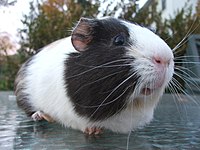
Photo from wikipedia
For ethical, technical, regulatory, and cost reasons, in vitro methods are increasingly used as an alternative to in vivo experimentations. The aim of the present study was to validate, according… Click to show full abstract
For ethical, technical, regulatory, and cost reasons, in vitro methods are increasingly used as an alternative to in vivo experimentations. The aim of the present study was to validate, according to in vivo data in living animals, a new in vitro model of the piglet colon, the PigutIVM, under both control conditions and antibiotic disturbance by the widely used colistin. The PigutIVM reproduces the main biotic and abiotic parameters of the piglet colon: temperature, pH, retention time, supply of ileal effluents, complex, and metabolically active microbiota and self-maintained anaerobiosis. Under both control and antibiotic-treated conditions, qPCR analyses showed that the main bacterial populations of piglet gut microbiota were similar in vitro and in vivo, with Pearson correlation coefficient higher than 0.9. During colistin administration, both in piglets and in the in vitro model, a significant decrease in Escherichia coli populations was observed together with changes in microbial composition of subdominant populations. SCFA concentrations were similar in vitro and in vivo and were not modified by colistin. Interestingly, the administration of the probiotic Saccharomyces cerevisiae var. boulardii CNCM I-1079 led in vitro to a decrease in E. coli levels, as previously observed when the antibiotic treatment was applied. This new in vitro model of the piglet colon provides a flexible, reproducible, and cost-effective tool for the screening of drugs or new dietary compounds, such as pre- or probiotics. It will be helpful for researchers, feed producers, or veterinarians when developing innovative non-antibiotic strategies.
Journal Title: Applied Microbiology and Biotechnology
Year Published: 2017
Link to full text (if available)
Share on Social Media: Sign Up to like & get
recommendations!